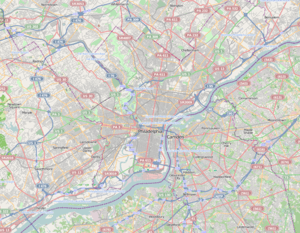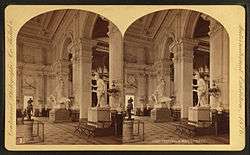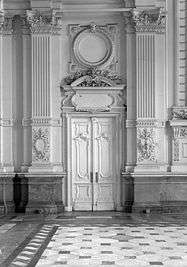Memorial Hall (Philadelphia)
|
Memorial Hall | |
|
Home of the Please Touch Museum | |
   | |
| Location |
West Fairmount Park 4231 Avenue of the Republic Philadelphia, Pennsylvania 19131 |
|---|---|
| Coordinates | 39°58′45″N 75°12′35″W / 39.97917°N 75.20972°WCoordinates: 39°58′45″N 75°12′35″W / 39.97917°N 75.20972°W |
| Built | 1876 |
| Architect | Herman J. Schwarzmann |
| Architectural style | Beaux-Arts |
| NRHP Reference # | 76001665[1] |
| Added to NRHP | December 8, 1976 |
Memorial Hall, is a Beaux-Arts style building in the Centennial District of West Fairmount Park, Philadelphia, Pennsylvania. Built as the art gallery for the 1876 Centennial Exposition, it subsequently housed the Pennsylvania Museum of Art (now the Philadelphia Museum of Art) and the Pennsylvania Museum School of Industrial Art (now the University of the Arts). Since October 18, 2008, the Hall has served as home to the Please Touch Museum.
The building is located west of the Schuylkill River, at the corner of East Memorial Hall Drive and the Avenue of the Republic.[2]
Background


Memorial Hall was designed by Herman J. Schwarzmann, and is an early example of monumental Beaux-Arts architecture in the United States. Schwarzmann, the chief engineer of the Fairmount Park Commission, also designed the temporary Horticultural Hall for the Exposition.[3] Construction began on 6 July 1874 and was completed for the opening ceremonies on 10 May 1876, at a cost of $1.5 million dollars. President Ulysses S. Grant and other dignitaries presided over the event, which was the first major world's fair to be hosted in the United States.[4]
The exterior is finished with granite and the interior is decorated with marble and ornamental plaster. The building is 365 feet (111 m) by 210 feet (64 m) with basement and ground floor, and 150 feet (46 m) tall at the top of the building's most distinctive feature, an iron and glass dome. Surmounting the dome is the 23-foot-tall (7.0 m) statue of Columbia (the poetic symbol of the United States) holding a laurel branch. At the corners of the dome stand four statues symbolizing industry, commerce, agriculture and mining. Memorial Hall was the inspiration for the Reichstag building in Berlin, Germany.[5]
Memorial Hall was designed to house the Centennial Exposition's art exhibits. The exposition received so many art contributions that a separate annex was built to house them all. Another building was built for the display of photography.[6]
After the Exposition, Memorial Hall reopened in 1877 as the Pennsylvania Museum School of Industrial Art and also served as the first home of the Philadelphia Museum of Art, which remained there until 1929. The building was taken over by the Fairmount Park Commission in 1958.[7][8] It also was used for a gymnasium and a swimming pool in both wings. In 1982, the building was being used as a police station.[8][9]
Philadelphia Orchestra recordings
In the 1980s and 1990s, the Philadelphia Orchestra made a number of recordings in a basketball court in Memorial Hall under the batons of Riccardo Muti and Wolfgang Sawallisch. Memorial Hall was used because the Academy of Music, the orchestra's home at the time, was considered not resonant enough.[10]
Richie Ashburn viewing
In September 1997, a viewing for former Philadelphia Phillies baseball player and long-time broadcaster Richie Ashburn was held shortly after his death from a heart attack in New York City. Several hundred thousand people mourned his death as they walked by his casket in the Grand Hall.
Please Touch Museum
The Hall fell into disrepair until 2005, when the Please Touch Museum began an $85-million renovation to convert it into its new home. The museum opened its doors to the public on October 18, 2008.[11] Memorial Hall's eastern lawn serves as the home field for Athletic Base Ball Club of Philadelphia, a vintage base ball team which plays by 1864 rules.
Gallery
 Nearing completion - March 7, 1876.
Nearing completion - March 7, 1876. East facade
East facade Southwest vestibule
Southwest vestibule Rotunda
Rotunda Statue near entrance
Statue near entrance

See also

 Philadelphia portal
Philadelphia portal
References
Notes
- ↑ National Park Service (2007-01-23). "National Register Information System". National Register of Historic Places. National Park Service.
- ↑ Caviglia, Ryan. "Treasure in the Park". The New Colonist. Retrieved August 2010. Check date values in:
|access-date=(help) - ↑ "Memorial Hall". Fairmount Park Commission. Retrieved August 2010. Check date values in:
|access-date=(help) - ↑ "History of Memorial Hall and the 1876 Centennial". Please Touch Museum. Retrieved August 2010. Check date values in:
|access-date=(help) - ↑ Filler, Martin, Makers of Modern Architecture, Volume 1, New York: The New York Review of Books, 2007, ISBN 978-1-59017-227-8, p. 226
- ↑ Philadelphia's 1876 Centennial Exhibition, pages 101 - 103
- ↑ Gross, Linda P.; Theresa R. Snyder (2005). Philadelphia's 1876 Centennial Exhibition. Arcadia Publishing. ISBN 0-7385-3888-4., page 105
- 1 2 Wainwright, Nicholas; Weigley, Russell; Wolf, Edwin (1982). Philadelphia: A 300-Year History. W.W. Norton & Company. ISBN 0-393-01610-2.
- ↑ Resinger, Kelly. "Memorial Hall Update". Please Touch Museum. Retrieved 2007-01-17.
- ↑ Dobrin, Peter. "A memorable musical moment at Memorial Hall". Philadelphia Inquirer. Retrieved 2012-08-19.
- ↑ "The History of Please Touch Museum" from the museum's official website
External links
 Media related to Memorial Hall (Philadelphia) at Wikimedia Commons
Media related to Memorial Hall (Philadelphia) at Wikimedia Commons- "Memorial Hall" U.S. History - Independence Hall Association
- "Memorial Hall". Fairmount Park Commission. Retrieved August 2010. Check date values in:
|access-date=(help) - Listing, drawings, and photographs at the Historic American Buildings Survey
- International Exhibition of 1876 Memorial Hall Philadelphia Buildings


